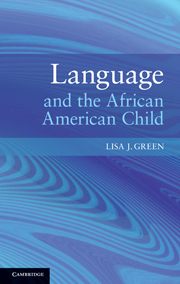Book contents
- Frontmatter
- Contents
- Figures
- Tables
- Foreword
- Preface
- Note on the text
- 1 Child AAE: an introductory overview of the data and context
- 2 Characterizing AAE: feature lists, dual components, and patterns and systems
- 3 System of tense–aspect marking 1: non-past and habitual
- 4 System of tense–aspect marking 2: past time
- 5 Negation: focus on negative concord
- 6 Asking questions: seeking clarification and requesting elaboration
- 7 Variation: intra-dialectal/variable-shifting and inter-dialectal/code-shifting
- 8 The D.I.R.E.C.T. Model: linking linguistic description and education
- Appendix A: List of participants
- Appendix B
- Notes
- References
- Index
Foreword
Published online by Cambridge University Press: 05 June 2012
- Frontmatter
- Contents
- Figures
- Tables
- Foreword
- Preface
- Note on the text
- 1 Child AAE: an introductory overview of the data and context
- 2 Characterizing AAE: feature lists, dual components, and patterns and systems
- 3 System of tense–aspect marking 1: non-past and habitual
- 4 System of tense–aspect marking 2: past time
- 5 Negation: focus on negative concord
- 6 Asking questions: seeking clarification and requesting elaboration
- 7 Variation: intra-dialectal/variable-shifting and inter-dialectal/code-shifting
- 8 The D.I.R.E.C.T. Model: linking linguistic description and education
- Appendix A: List of participants
- Appendix B
- Notes
- References
- Index
Summary
When a pre-eminent scholar in theoretical linguistics turns her hand to the topic of child language, one can expect novel insights and expository innovation. Lisa J. Green has brought her incomparable knowledge of African American English to bear upon conversations with black children. Many of these exchanges have emerged from her seminal experimental work, but, with a touch of genius, she elucidates the intricate grammatical tapestry behind ordinary conversations. She preserves our sense of real children as she exposes how they bring together elliptical discourse, intonation, and subtle semantic implications when they just answer an ordinary question or make a heartfelt assertion.
Thus she is able to illustrate the most tantalizing features of AAE with careful situation-grounded discussions: aspect, tense, negation, and question formation. Her explorations of and sensitivity to verbatim and elliptical meanings constitute an advance in acquisition research as well. We learn a great deal from this kind of microscopic dissection of real conversations that cannot be gleaned from statistical summaries of naturalistic data or cross-sectional experimental work. Children’s own explanations reveal much more about their grammars than first language researchers have thus far realized.
- Type
- Chapter
- Information
- Language and the African American Child , pp. xiii - xxPublisher: Cambridge University PressPrint publication year: 2010

